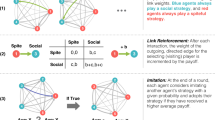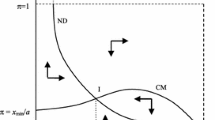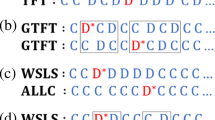Abstract
Spite in Hamilton’s sense is defined as the willingness to harm oneself in order to harm another more. The standard replicator dynamic predicts that evolutionarily stable strategies are payoff-maximizing equilibria of the underlying game, and hence rules out the evolution of spiteful behavior. We propose a modified replicator dynamic, where selection is based on local outcomes, rather than on the population ’state’, as in standard models. We show that under this new model spite can evolve readily. The new dynamic suggests conditions under which spite in animals might be found.
Similar content being viewed by others
References
Björnerstedt, J. and J. W. Weibull (1996). Nash equilibrium and evolution by imitation, in The Rational Foundations of Economic Behavior, Proceedings of the IEA Conf., Turin, Italy, K. J. Arrow, E. Colombatto, M. Perlman and C. Schmidt (Eds), New York: St. Martin’s Press.
Foster, K. R., T. Wenseleers and F. L. W. Ratnieks (2001). Spite: Hamilton’s unproven theory. Ann. Zool. Fennici 38, 229–238.
Gadagkar, R. (1993). Can animals be spiteful? Trends in Ecology and Evolution 8, 232–234. See also Keller, L., M. Milinski, M. Frischknecht, N. Perrin, H. Richner and F. Tripet (1994). Spiteful animals still to be discovered. ibid. 9, 103, and reply.
Gintis, H. (2000). Game Theory Evolving, Princeton: Princeton University Press.
Hamilton, W. D. (1970). Selfish and spiteful behaviour in an evolutionary model. Nature 228, 1218–1220.
Hofbauer, J. and K. Sigmund (1998). Evolutionary Games and Population Dynamics, Cambridge: Cambridge University Press.
Knowlton, N. and G. A. Parker (1979). An evolutionarily stable strategy approach to indiscriminate spite. Nature 279, 419–421.
Maynard Smith, J. (1982). Evolution and the Theory of Games, Cambridge: Cambridge University Press.
Morgan, J., K. Steiglitz and G. Reis (2003). The spite motive and equilibrium behavior in auctions. Contributions to Economic Analysis & Policy 2, Article 5; http://www.bepress.com/bejeap/contributions/vol2/iss1/art5.
Rothstein, S. I. (1979). Gene frequencies and selection for inhibitory traits, with special emphasis on the adaptiveness of territoriality. Am. Nat. 113, 317–331.
Verner, J. (1977). On the adaptive significance of territoriality. Am. Nat. 111, 769–775.
Weibull, J. W. (1995). Evolutionary Game Theory, Cambridge, MA: MIT Press.
Author information
Authors and Affiliations
Corresponding author
Rights and permissions
About this article
Cite this article
Morgan, J., Steiglitz, K. Pairwise competition and the replicator equation. Bull. Math. Biol. 65, 1163–1172 (2003). https://doi.org/10.1016/j.bulm.2003.08.001
Received:
Accepted:
Issue Date:
DOI: https://doi.org/10.1016/j.bulm.2003.08.001




